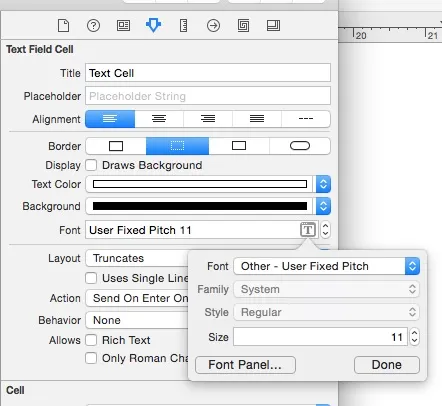如何设置NSTableView列使用等宽数字?
7
- Kornel
3
你是如何填充这些单元格的?使用绑定还是使用NSTableViewDataSource中的某些内容(例如['tableView:objectValueForTableColumn:row:'](https://developer.apple.com/library/mac/documentation/Cocoa/Reference/ApplicationKit/Protocols/NSTableDataSource_Protocol/#//apple_ref/occ/intfm/NSTableViewDataSource/tableView:objectValueForTableColumn:row:))? - Michael Dautermann
@MichaelDautermann 我正在使用NSArrayController绑定。 - Kornel
我认为应该接受Johan的答案,因为它没有使用私有API。 - ctietze
4个回答
11
如果可用,只需使用 +[NSFont monospacedDigitSystemFontOfSize:weight:]。它在10.11中是新功能,但仍未包含在NSFont文档中。它在头文件中,并在WWDC 2015视频中有讨论。因此,类似以下内容:
if ([NSFont respondsToSelector:@selector(monospacedDigitSystemFontOfSize:weight:)])
textField.font = [NSFont monospacedDigitSystemFontOfSize:textField.font.pointSize weight:NSFontWeightRegular];
- Ken Thomases
5
这里有一个Swift扩展,可以提供具有高可读性的等宽数字字体。
extension NSFont {
var legibleNumbersVariant: NSFont {
let features = [
[NSFontFeatureTypeIdentifierKey: kNumberSpacingType,
NSFontFeatureSelectorIdentifierKey: kMonospacedNumbersSelector],
[NSFontFeatureTypeIdentifierKey: kStylisticAlternativesType,
NSFontFeatureSelectorIdentifierKey: kStylisticAltSixOnSelector]
]
let descriptor = fontDescriptor.addingAttributes([NSFontFeatureSettingsAttribute: features])
return NSFont(descriptor: descriptor, size: pointSize) ?? self
}
}
- Johan Nordberg
4
请将以下内容视为伪代码,快速完成,未经彻底测试等。
给定一个表示具有等宽数字特征的字体的NSFont,以下方法将产生另一个选择了该特征的NSFont:
- (NSFont *) newMonospaceNumbersFont:(NSFont *)font
{
CTFontDescriptorRef origDesc = CTFontCopyFontDescriptor((__bridge CTFontRef)font);
CTFontDescriptorRef monoDesc = CTFontDescriptorCreateCopyWithFeature(origDesc, (__bridge CFNumberRef)@(kNumberSpacingType), (__bridge CFNumberRef)@(kMonospacedNumbersSelector));
CFRelease(origDesc);
CTFontRef monoFont = CTFontCreateWithFontDescriptor(monoDesc, font.pointSize, NULL);
CFRelease(monoDesc);
return (__bridge_transfer NSFont *)monoFont;
}
你可以使用这个方法,例如将UI元素的当前字体转换为具有等宽数字的字体。
希望对你有所帮助。
Swift变量:
假设“res”是要显示数字的“NSTextField”:
let origDesc = CTFontCopyFontDescriptor(res.font!)
let monoDesc = CTFontDescriptorCreateCopyWithFeature(origDesc, kNumberSpacingType, kMonospacedNumbersSelector)
let monoFont = CTFontCreateWithFontDescriptor(monoDesc, res.font!.pointSize, nil)
res.font = monoFont
- CRD
网页内容由stack overflow 提供, 点击上面的可以查看英文原文,
原文链接
原文链接



